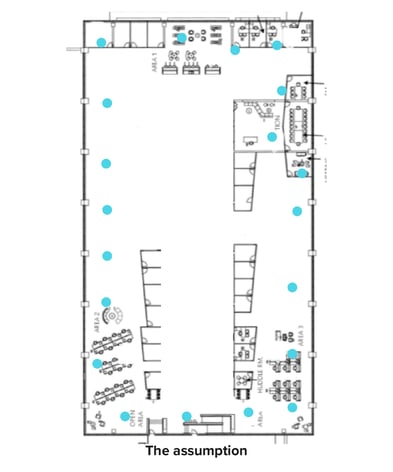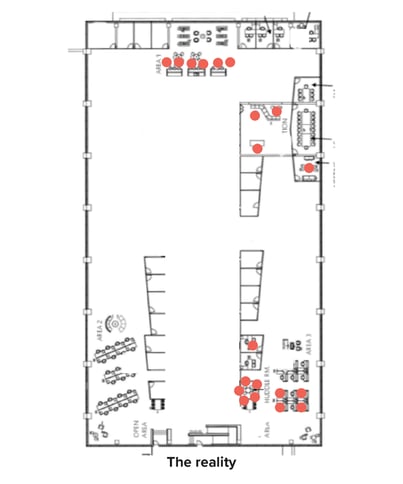InnerSpace Metrics: How to Measure Density
Data captured by our leading Wi-Fi-based spatial intelligence platform enables companies to take advantage of their two greatest resources: people and property. Here, we explore the right way to measure density.
In the new office paradigm, understanding and leveraging the data you need to maintain a safe office environment is critical. That’s where the importance of density is paramount – but not just in terms of the number of people in an overall space. Truly valuable insights come from going beyond occupancy data alone, to explore where people are working in real-time – and areas they tend to prefer, based on long term patterns.
Here we compare the merits of using occupancy data vs Wi-Fi-based space utilization data to measure density in office spaces.
The basics of density measurement
For employers with a deep real estate portfolio, understanding true measures of density is essential.
Before COVID, the impetus was to ensure the office was used to its highest potential, designed in a way to best support employees and enhance productivity. While still important, so too now is ensuring that employees feel safe and that the office serves evolving needs – like prioritizing collaboration and flexible work schedules.
One method to understand density is to measure occupancy – the number of people in the space at any given time. Deploying sensors that record and provide this data enables companies to get a very high-level look at the number of people inside a building, or on a particular floor or level. This number can be divided by the total square footage to get a high-level density number.
# of people (occupancy) / total square feet = density
While useful to some degree, this is minimal intel. This bird’s eye data is difficult to work with, because it doesn’t reveal what’s happening within specific areas and zones within that entire building or floor – insights that directly inform safety efforts and efficient use of resources (for starters).
Trusting only occupancy sensors, or worse, badge counts and security cameras, won’t provide deep enough insight useful enough to move the needle in the new office paradigm. Instead, we suggest going one step further.
Density 2.0
While the basics are a good starting point, with so much at stake – from the health of employees to the sustainability of a business over the long term – it’s imperative to take that extra step.
Density metrics that stream from Wi-Fi-enabled space utilization data are an evolution in uncovering answers to questions like:
- Are collaboration zones under- or over-utilized?
- How does the hot-desking density compare to the assigned seating density?
- Where are employees tending to congregate?
With InnerSpace’s spatial intelligence platform, patterns of use and travel pathways can be assessed to calculate density across a floor plan by zones. This provides detailed insights into exactly how a space is being used in real time. It identifies hotspots in real time and helps workplace managers respond to situations as they happen.
Consider this scenario: Occupancy data may show overall office density at 35 percent. Depending on office policies, this might suggest everything is working as intended. However, because it is not deep intel, it can risk providing a false sense of security. That’s because the people inside may be predominantly camped in specific rooms or individual zones – while three-quarters of the office space is actually empty. This is clearly an issue for both physical distancing and space optimization.


To get the real picture, a more comprehensive spatial intelligence platform captures the data needed to measure density in a way that is truly valuable. The InnerSpace platform yields such metrics that occupancy sensors alone simply cannot:
- Density by zone: Real-time data on number of people per sq ft in a particular zone of the office.
- Density by floor: A handy metric for large employers with a deep real estate footprint.
High risk area: Should one office area regularly exceed capacity, the system will highlight the problem visually.
Looking ahead
In an era where social distancing, compliance, design, and employee comfort/safety are table stakes, having an always-on system is the only way to truly assess what’s happening in a space.
InnerSpace’s Wi-Fi-based workplace intelligence shows how many times areas were at risk, or over-capacity. It highlights office zones that are underused or underperforming – allowing leaders to readjust seating plans or collaboration spaces accordingly. It enables companies to calculate density right down to the zone and room level, a unique value proposition that will propel companies toward a sustainable future.
Get in touch to learn more about how our platform can work for your specific needs.
Accurate space utilization data through Wi-Fi?
We'll prove it to you.
See why industry leaders leverage InnerSpace to generate valuable insights that go beyond occupancy.

